Ziyang Huang
Opt3DGS: Optimizing 3D Gaussian Splatting with Adaptive Exploration and Curvature-Aware Exploitation
Nov 17, 2025Abstract:3D Gaussian Splatting (3DGS) has emerged as a leading framework for novel view synthesis, yet its core optimization challenges remain underexplored. We identify two key issues in 3DGS optimization: entrapment in suboptimal local optima and insufficient convergence quality. To address these, we propose Opt3DGS, a robust framework that enhances 3DGS through a two-stage optimization process of adaptive exploration and curvature-guided exploitation. In the exploration phase, an Adaptive Weighted Stochastic Gradient Langevin Dynamics (SGLD) method enhances global search to escape local optima. In the exploitation phase, a Local Quasi-Newton Direction-guided Adam optimizer leverages curvature information for precise and efficient convergence. Extensive experiments on diverse benchmark datasets demonstrate that Opt3DGS achieves state-of-the-art rendering quality by refining the 3DGS optimization process without modifying its underlying representation.
Mixture-of-Schedulers: An Adaptive Scheduling Agent as a Learned Router for Expert Policies
Nov 07, 2025Abstract:Modern operating system schedulers employ a single, static policy, which struggles to deliver optimal performance across the diverse and dynamic workloads of contemporary systems. This "one-policy-fits-all" approach leads to significant compromises in fairness, throughput, and latency, particularly with the rise of heterogeneous hardware and varied application architectures. This paper proposes a new paradigm: dynamically selecting the optimal policy from a portfolio of specialized schedulers rather than designing a single, monolithic one. We present the Adaptive Scheduling Agent (ASA), a lightweight framework that intelligently matches workloads to the most suitable "expert" scheduling policy at runtime. ASA's core is a novel, low-overhead offline/online approach. First, an offline process trains a universal, hardware-agnostic machine learning model to recognize abstract workload patterns from system behaviors. Second, at runtime, ASA continually processes the model's predictions using a time-weighted probability voting algorithm to identify the workload, then makes a scheduling decision by consulting a pre-configured, machine-specific mapping table to switch to the optimal scheduler via Linux's sched_ext framework. This decoupled architecture allows ASA to adapt to new hardware platforms rapidly without expensive retraining of the core recognition model. Our evaluation, based on a novel benchmark focused on user-experience metrics, demonstrates that ASA consistently outperforms the default Linux scheduler (EEVDF), achieving superior results in 86.4% of test scenarios. Furthermore, ASA's selections are near-optimal, ranking among the top three schedulers in 78.6% of all scenarios. This validates our approach as a practical path toward more intelligent, adaptive, and responsive operating system schedulers.
Socratic-PRMBench: Benchmarking Process Reward Models with Systematic Reasoning Patterns
May 29, 2025Abstract:Process Reward Models (PRMs) are crucial in complex reasoning and problem-solving tasks (e.g., LLM agents with long-horizon decision-making) by verifying the correctness of each intermediate reasoning step. In real-world scenarios, LLMs may apply various reasoning patterns (e.g., decomposition) to solve a problem, potentially suffering from errors under various reasoning patterns. Therefore, PRMs are required to identify errors under various reasoning patterns during the reasoning process. However, existing benchmarks mainly focus on evaluating PRMs with stepwise correctness, ignoring a systematic evaluation of PRMs under various reasoning patterns. To mitigate this gap, we introduce Socratic-PRMBench, a new benchmark to evaluate PRMs systematically under six reasoning patterns, including Transformation, Decomposition, Regather, Deduction, Verification, and Integration. Socratic-PRMBench}comprises 2995 reasoning paths with flaws within the aforementioned six reasoning patterns. Through our experiments on both PRMs and LLMs prompted as critic models, we identify notable deficiencies in existing PRMs. These observations underscore the significant weakness of current PRMs in conducting evaluations on reasoning steps under various reasoning patterns. We hope Socratic-PRMBench can serve as a comprehensive testbed for systematic evaluation of PRMs under diverse reasoning patterns and pave the way for future development of PRMs.
Improve Rule Retrieval and Reasoning with Self-Induction and Relevance ReEstimate
May 16, 2025Abstract:This paper systematically addresses the challenges of rule retrieval, a crucial yet underexplored area. Vanilla retrieval methods using sparse or dense retrievers to directly search for relevant rules to support downstream reasoning, often suffer from low accuracy. This is primarily due to a significant semantic gap between the instantiated facts in the queries and the abstract representations of the rules. Such misalignment results in suboptimal retrieval quality, which in turn negatively impacts reasoning performance. To overcome these challenges, we propose Self-Induction Augmented Retrieval (SIAR), a novel approach that utilizes Large Language Models (LLMs) to induce potential inferential rules that might offer benefits for reasoning by abstracting the underlying knowledge and logical structure in queries. These induced rules are then used for query augmentation to improve retrieval effectiveness. Additionally, we introduce Rule Relevance ReEstimate (R$^3$), a method that re-estimates the relevance of retrieved rules by assessing whether the abstract knowledge they contain can be instantiated to align with the facts in the queries and the helpfulness for reasoning. Extensive experiments across various settings demonstrate the effectiveness and versatility of our proposed methods.
Reinforced Internal-External Knowledge Synergistic Reasoning for Efficient Adaptive Search Agent
May 12, 2025Abstract:Retrieval-augmented generation (RAG) is a common strategy to reduce hallucinations in Large Language Models (LLMs). While reinforcement learning (RL) can enable LLMs to act as search agents by activating retrieval capabilities, existing ones often underutilize their internal knowledge. This can lead to redundant retrievals, potential harmful knowledge conflicts, and increased inference latency. To address these limitations, an efficient and adaptive search agent capable of discerning optimal retrieval timing and synergistically integrating parametric (internal) and retrieved (external) knowledge is in urgent need. This paper introduces the Reinforced Internal-External Knowledge Synergistic Reasoning Agent (IKEA), which could indentify its own knowledge boundary and prioritize the utilization of internal knowledge, resorting to external search only when internal knowledge is deemed insufficient. This is achieved using a novel knowledge-boundary aware reward function and a knowledge-boundary aware training dataset. These are designed for internal-external knowledge synergy oriented RL, incentivizing the model to deliver accurate answers, minimize unnecessary retrievals, and encourage appropriate external searches when its own knowledge is lacking. Evaluations across multiple knowledge reasoning tasks demonstrate that IKEA significantly outperforms baseline methods, reduces retrieval frequency significantly, and exhibits robust generalization capabilities.
Exploiting Contextual Knowledge in LLMs through V-usable Information based Layer Enhancement
Apr 22, 2025Abstract:Large Language Models (LLMs) have demonstrated remarkable capabilities in various tasks, yet they often struggle with context-faithfulness generations that properly reflect contextual knowledge. While existing approaches focus on enhancing the decoding strategies, they ignore the fundamental mechanism of how contextual information is processed within LLMs' internal states. As a result, LLMs remain limited in their ability to fully leverage contextual knowledge. In this paper, we propose Context-aware Layer Enhancement (CaLE), a novel intervention method that enhances the utilization of contextual knowledge within LLMs' internal representations. By employing V-usable information analysis, CaLE strategically amplifies the growth of contextual information at an optimal layer, thereby enriching representations in the final layer. Our experiments demonstrate that CaLE effectively improves context-faithful generation in Question-Answering tasks, particularly in scenarios involving unknown or conflicting contextual knowledge.
$μ$KE: Matryoshka Unstructured Knowledge Editing of Large Language Models
Apr 01, 2025



Abstract:Large language models (LLMs) have emerged as powerful knowledge bases yet are limited by static training data, leading to issues such as hallucinations and safety risks. Editing a model's internal knowledge through the locate-and-edit paradigm has proven a cost-effective alternative to retraining, though current unstructured approaches, especially window-based autoregressive methods, often disrupt the causal dependency between early memory updates and later output tokens. In this work, we first theoretically analyze these limitations and then introduce Matryoshka Unstructured Knowledge Editing ($\mu$KE), a novel memory update mechanism that preserves such dependencies via a Matryoshka-style objective and adaptive loss coefficients. Empirical evaluations on two models across four benchmarks demonstrate that $\mu$KE improves edit efficacy by up to 12.33% over state-of-the-art methods, and remain robust when applied to diverse formatted edits, underscoring its potential for effective unstructured knowledge editing in LLMs.
Towards Adaptive Mechanism Activation in Language Agent
Dec 01, 2024Abstract:Language Agent could be endowed with different mechanisms for autonomous task accomplishment. Current agents typically rely on fixed mechanisms or a set of mechanisms activated in a predefined order, limiting their adaptation to varied potential task solution structures. To this end, this paper proposes \textbf{A}daptive \textbf{L}anguage \textbf{A}gent \textbf{M}echanism \textbf{A}ctivation Learning with Self-Exploration (\textbf{ALAMA}), which focuses on optimizing mechanism activation adaptability without reliance on expert models. Initially, it builds a harmonized agent framework (\textbf{UniAct}) to \textbf{Uni}fy different mechanisms via \textbf{Act}ions. Then it leverages a training-efficient optimization method based on self-exploration to enable the UniAct to adaptively activate the appropriate mechanisms according to the potential characteristics of the task. Experimental results demonstrate significant improvements in downstream agent tasks, affirming the effectiveness of our approach in facilitating more dynamic and context-sensitive mechanism activation.
* COLING2025
Beyond Instruction Following: Evaluating Rule Following of Large Language Models
Jul 11, 2024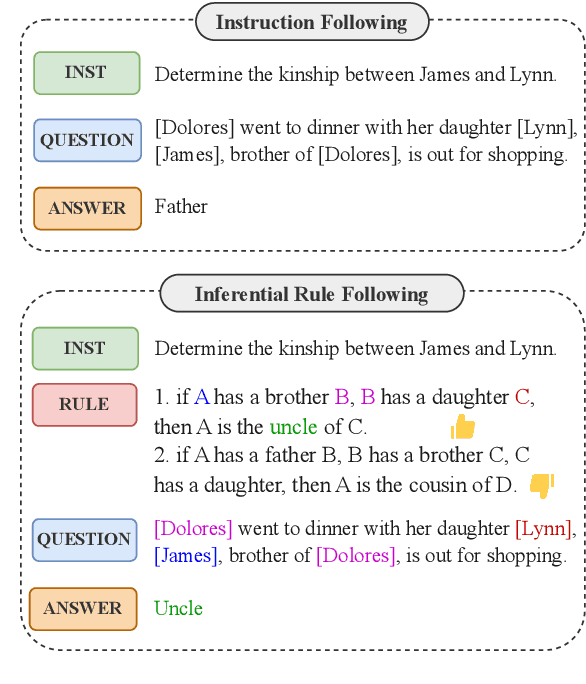



Abstract:Although Large Language Models (LLMs) have demonstrated strong instruction-following ability to be helpful, they are further supposed to be controlled and guided by rules in real-world scenarios to be safe, and accurate in responses. This demands the possession of rule-following capability of LLMs. However, few works have made a clear evaluation of the rule-following capability of LLMs. Previous studies that try to evaluate the rule-following capability of LLMs fail to distinguish the rule-following scenarios from the instruction-following scenarios. Therefore, this paper first makes a clarification of the concept of rule-following, and curates a comprehensive benchmark, RuleBench, to evaluate a diversified range of rule-following abilities. Our experimental results on a variety of LLMs show that they are still limited in following rules. Our further analysis provides insights into the improvements for LLMs toward a better rule-following intelligent agent. The data and code can be found at: https://anonymous.4open.science/r/llm-rule-following-B3E3/
Source Code Foundation Models are Transferable Binary Analysis Knowledge Bases
May 30, 2024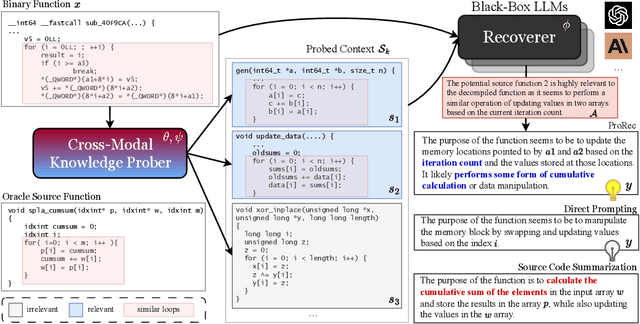
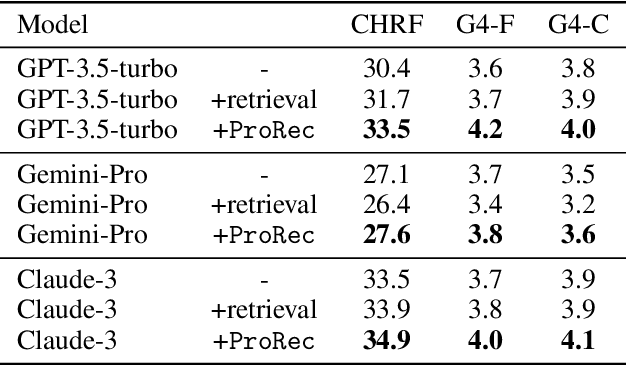
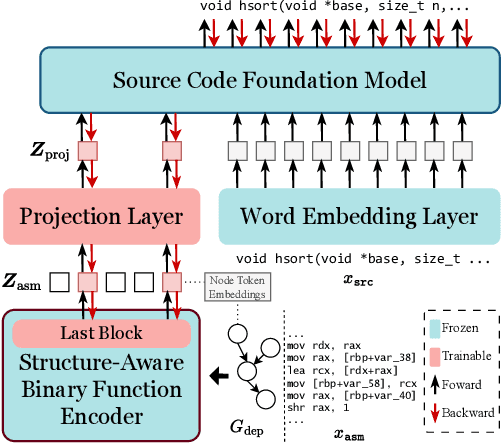
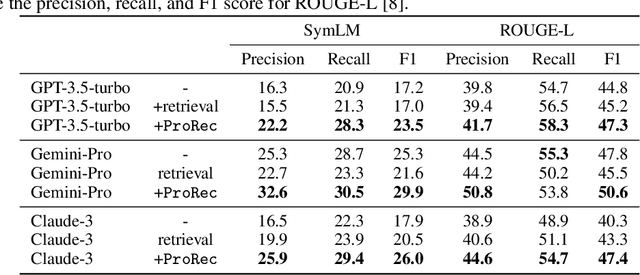
Abstract:Human-Oriented Binary Reverse Engineering (HOBRE) lies at the intersection of binary and source code, aiming to lift binary code to human-readable content relevant to source code, thereby bridging the binary-source semantic gap. Recent advancements in uni-modal code model pre-training, particularly in generative Source Code Foundation Models (SCFMs) and binary understanding models, have laid the groundwork for transfer learning applicable to HOBRE. However, existing approaches for HOBRE rely heavily on uni-modal models like SCFMs for supervised fine-tuning or general LLMs for prompting, resulting in sub-optimal performance. Inspired by recent progress in large multi-modal models, we propose that it is possible to harness the strengths of uni-modal code models from both sides to bridge the semantic gap effectively. In this paper, we introduce a novel probe-and-recover framework that incorporates a binary-source encoder-decoder model and black-box LLMs for binary analysis. Our approach leverages the pre-trained knowledge within SCFMs to synthesize relevant, symbol-rich code fragments as context. This additional context enables black-box LLMs to enhance recovery accuracy. We demonstrate significant improvements in zero-shot binary summarization and binary function name recovery, with a 10.3% relative gain in CHRF and a 16.7% relative gain in a GPT4-based metric for summarization, as well as a 6.7% and 7.4% absolute increase in token-level precision and recall for name recovery, respectively. These results highlight the effectiveness of our approach in automating and improving binary code analysis.
 Add to Chrome
Add to Chrome Add to Firefox
Add to Firefox Add to Edge
Add to Edge